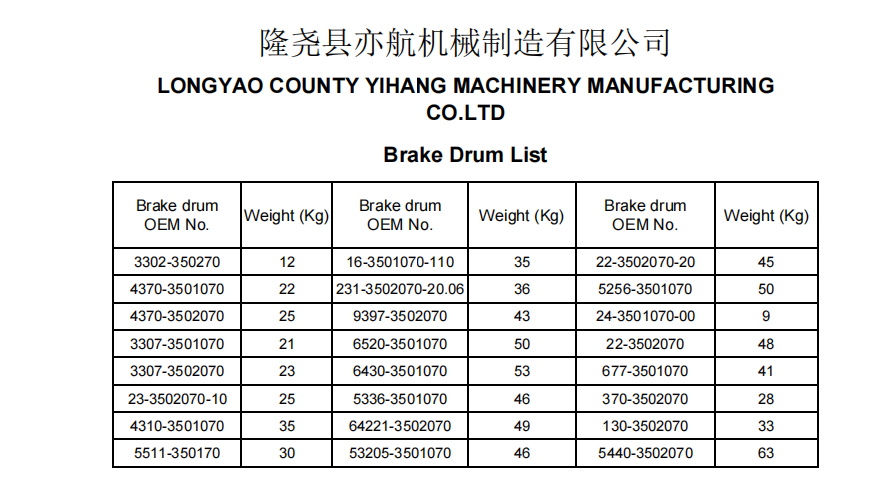Dec . 07, 2024 08:21 Back to list
signs of a warped brake drum
Signs of a Warped Brake Drum Understanding the Indicators
Brake drums play a crucial role in the braking system of many vehicles, particularly those with drum brakes. They are designed to house the brake shoes, which press against the inside of the drum to create the necessary friction for slowing down or stopping the vehicle. However, like any mechanical component, brake drums can experience issues over time, with warping being one of the most prevalent problems. Understanding the signs of a warped brake drum is essential for ensuring your vehicle's safety and performance.
What Causes Warping?
Brake drum warping typically occurs due to excessive heat buildup. This can happen for several reasons, including frequent heavy braking, driving with a heavy load, or using inferior quality brake components. When the brake drum is overheated, the metal expands unevenly, which can lead to warping. Once warped, the surface of the drum becomes uneven, causing reduced effectiveness in the braking system.
Key Signs of a Warped Brake Drum
1. Vibrations When Braking One of the most noticeable signs of a warped brake drum is vibrations felt in the brake pedal or the steering wheel when applying the brakes. As the brake shoes press against the irregular surface of the warped drum, the uneven contact leads to a pulsating effect that translates into vibrations. This can be particularly prominent during high-speed braking.
2. Uneven Brake Wear If you notice that your brake shoes are wearing unevenly, it could be an indicator of a warped brake drum. Since the drum's surface is not uniform, the brake shoes may contact certain areas more than others, leading to accelerated wear on specific parts. Regular inspections can help identify this issue early on.
3. Increased Stopping Distance A warped brake drum compromises the braking force needed to stop your vehicle effectively. If you find that you have to press the brake pedal harder or for longer to achieve the desired stopping power, this could be a sign of a problem. Such changes could put you at risk, especially in emergency situations.
signs of a warped brake drum

4. Burning Smell An unusual burning smell, particularly after prolonged driving or heavy braking, can indicate brake overheating, which might contribute to warping. If the brake drum becomes excessively hot, it can cause the brake shoes to overheat as well, leading to further damage and potentially causing the brake material to deteriorate.
5. Metallic Noise Another symptom of a warped brake drum can be a metallic grinding or scraping noise when braking. This noise may occur particularly when the brake shoes begin to wear down and make contact with the warped areas of the drum. Any unusual sounds during braking should not be ignored, as they often signal an underlying issue.
6. Dashboard Warning Lights In some modern vehicles, warning lights on the dashboard may indicate issues with the braking system. If you see any brake-related alerts, it’s crucial to have the system inspected by a professional. While these warnings may not specifically point to a warped drum, they can highlight other significant braking concerns.
Addressing the Issue
If you suspect that your brake drums might be warped, it's important to address the issue promptly. Ignoring the signs can lead to more severe problems down the line, including complete brake failure. A professional mechanic can assess the condition of the brake drums through visual inspection and measurements. In some cases, the drums can be resurfaced to restore their integrity, but often, replacement is necessary.
Conclusion
Understanding the signs of a warped brake drum is crucial for maintaining your vehicle's safety and efficiency. Regular vehicle maintenance, monitoring your braking performance, and being aware of the warning signs can help you catch issues early, ensuring a safer driving experience. If you detect any of the aforementioned symptoms, do not hesitate to consult with a qualified technician to safeguard your vehicle's braking system.
-
ROR Web Development: Build Fast, Scalable, Secure Apps
NewsAug.17,2025
-
Scania Brake Drums: OEM Quality for Optimal Safety & Durability
NewsAug.16,2025
-
R.V.I: Advanced Remote Visual Inspection for Precision
NewsAug.15,2025
-
Discover HYUNDA: Innovative Vehicles, Equipment & Solutions
NewsAug.14,2025
-
R.V.I: Unlock Advanced Insights & Real-time Performance
NewsAug.13,2025
-
Kamaz Brake Drum: Durable & Reliable for Heavy Duty Trucks
NewsAug.12,2025
